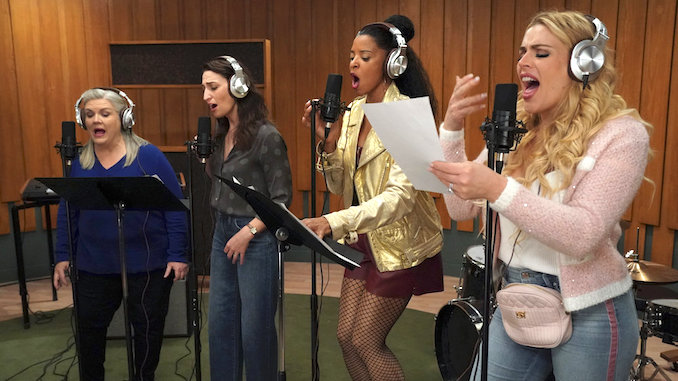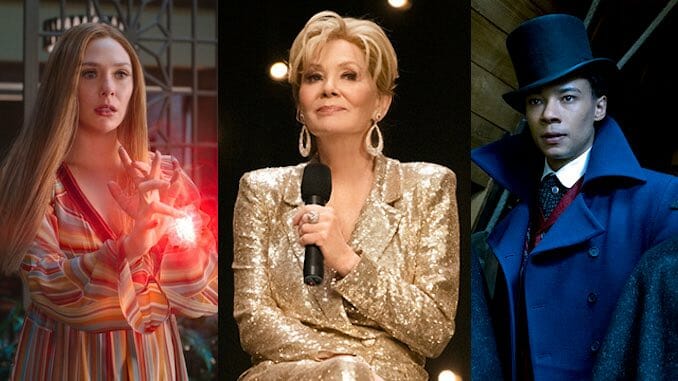
As is tradition in the celebration of good entertainment, the Paste staffers and TV writers have voted on our favorite TV shows of 2021—so far. To be eligible, series needed to premiere or have aired a significant number of episodes between January 1 and May 31. We’ve also included where you can stream these series (if available) so you can catch up on any you might have missed.
One of the biggest differences from our 2020 list, though, is the impact of new streaming services and what the COVID-19 shutdowns have meant for the TV landscape. This list, and TV in general, has been dominated by first season shows or miniseries while our ongoing favorites have been on a production hiatus. Further, the selections below doesn’t feature any series from Hulu and FX, both of which have been heavy hitters for us in the past. Instead, the top network here is HBO Max, both for its HBO series and Max originals, with four total picks. Next, with three, is Disney+, which has been reliably producing four-quadrant hits. Netflix, Amazon, and newcomer Peacock each have two, and the rest are spread out among cable, streaming, and broadcast television. Even though Peak TV has diminished, it seems like we’re entering an era of dispersed TV; great series are being peppered throughout, but unfortunately you would need a lot of subscriptions to catch ‘em all.
Still, hopefully you can find a few great under-the-radar picks for the services you currently subscribe to, or find a reason to at least do a free trial to experience a few more. Great TV deserves attention! Here’s where we’re bestowing ours:
![]()
20. The Falcon and the Winter Soldier

Network: Disney+
Season: 1
A somewhat controversial pick, The Falcon and the Winter Soldier was a show everyone watched and everyone thought was at least fine. For our list, it benefited from the Joe Biden Effect; no one was enthused, but everyone agreed it should be included. What a legacy!
But the show set up some interesting narratives beyond its brutal, cinematic-quality action sequences; for Sam/Falcon (Anthony Mackie) and Bucky/Winter Soldier (Sebastian Stan), their time with the Avengers had been a kind of extended military tour of duty. Now, Sam is trying to reconnect with his widowed sister and her sons, and save his family’s fishing business. When they go to apply for a loan, there’s a cheeky reference to “how do [the Avengers] make money?” with no good answer. “Isn’t there some kind of Hero’s Fund?” the loan officer asks. This and the general hesitation for the loan to be approved feels like a not-so-coded reference to very real issues and biases faced by veterans, especially BIPOC veterans. Meanwhile, Bucky’s issues are largely internal. He isn’t in financial trouble, but he has no friends or family. When his therapist tells him that he’s free now, he answers “to do what?” He’s 106 years old, has no history and no life, and finds the modern world overwhelming and alienating.
TFATWS is set very firmly in our own world (and it presupposes a fairly deep knowledge of the Marvel and its movies); tonally it’s along the lines of The Winter Soldier and the start of Civil War, at least regarding political jockeying and America-centric military issues. That’s both good and bad. On the one hand, the series could have delved into some very worthy considerations of what it means to serve, to come home, to feel unmoored by a world that has moved past you. It chose to go another way. For those who prefer action set pieces and comic lore, it was a feast. For others, something of a tangled bore. But then Baron Zemo danced, and who are we to disagree with its greatness? These little moments made TFATWS shine. —Allison Keene
19. Beartown

Network: HBO Max
Season: Miniseries
Through five episodes, the limited Swedish series Beartown tells the story of Peter Andersson (Ulf Stenberg), a retired NHL player who returns to his hometown (Bjornstad, which translates to “Beartown”) with his wife and two children to coach the semi-professional hockey team. Bjornstad is a failing, dilapidated town steeped in Nordic misery, and the hockey team is a perfect reflection of the people: sad, old, and almost hopeless. Andersson, who comes with his own tragic burden—his young son died while he lived in North America—decides that the only way he’ll continue is if he can coach the junior team. There, he can utilize the talents of Kevin Erdahl (Oliver Dufaker), the son of his former rival, a prodigious talent who spends hours outside his home on the cold winter nights, slapping puck after puck into a net hung with targets.
There’s an almost Robert Altman-esque vibe to many of the scenes, in the sense that overlapping conversation and seemingly improvised bits of dialogue add credibility to a party scene, or a locker room speech, or the chatter of parents in the stands. Through these methods, director Peter Gronlund establishes a wonderful flow that nearly goes unnoticed amid the story and the drama, but that is essential to the world-building which seems to capture a viewer so effortlessly. And it should come as no surprise that the hockey scenes are also executed extremely well, which is quite an effort considering that this is only a “sports” show in the loosest sense.
This ingredient and all others cohere seamlessly, and you’re left with a show that transcends noir even as it elevates it. It’s clear that noir generally—and Scandi-noir specifically—hold a special appeal to modern audiences, and it’s clearer still that in the race to pump out as many as possible, some of the vibrant energy of what makes it special has been lost. There is no serial killer in Beartown, there is no religious iconography, no mass conspiracy, no last-minute twists to justify hours of uncertainty. There are only human beings, lost in a landscape, subject to the nightmares and redemptions that have plagued and absolved us from the start, and from which we’re called upon to rise even as the earthly world extends its cold, familiar shackles. —Shane Ryan
18. The Bite
Network: Spectrum
Season: 1
[Not currently streaming]
Leave it Robert and Michelle King, the husband and wife team behind Evil and The Good Fight, to tackle the COVID-19 pandemic with such hilarious aplomb; the Kings have always had the ability to make viewers laugh while helping them to confront some harsh truths. Rachel (Audra McDonald) is a doctor living in New York City spending her days doing tele-visits while her husband Zach (Steven Pasquale) is in Washington, D.C. working for the CDC. Rachel is navigating patients who don’t exactly take the virus seriously. “I’ve lost my sense of taste which is fine. It keeps me from snacking,” a patient tells Rachel after attending a COVID party. Rachel’s upstairs neighbor Lily (Taylor Schilling) continues her dominatrix business virtually. But when one of Rachel’s patients is bitten by a grocery clerk at Trader Joe’s, Rachel soon realizes this latest variant of the virus is more concerning than anyone could have known.
The Kings’ trademark skewering of pop-culture is on delightful display (a website called Room Rankers watches the world’s rooms “so you don’t have to”), and its takedown of the political system is spot on: government officials want to call the outbreak Sun-9 because “the S sound is more pleasing to the ear.” The six-episode series is reminiscent of the Kings’ short-lived BrainDead, but even more relevant now. Our only regret is that its airing on Spectrum, which means far too many viewers won’t be able to see this fantastic series.—Amy Amatangelo
17. Legends of Tomorrow
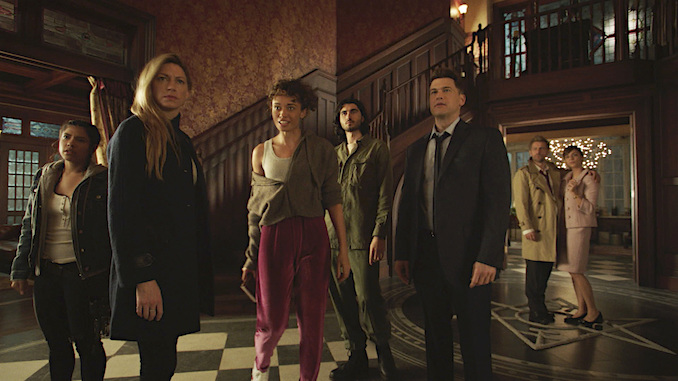
Network: The CW
Season: 6
A superhero show that doesn’t really connect with anything other than its own crazy self continues to be a balm in a saturated landscape. Never afraid to mix things up or take big swings, Legends of Tomorrow rewards its viewers not only with meta humor and references, but by allowing its heroes to have fun, find joy, and make us laugh. Though the team continues to change, their affable connections make us care about them emotionally, and it’s one of the few superhero shows that allows its team to be actual adults—sex, drugs, and rock ’n roll are all part of the story, and yet it’s a playground rather than a mire of seriousness.
In its sixth season, the CW’s brave and bonkers show is boldly going where it’s never gone before, sending the titular Legends through time to battle displaced aliens in an attempt to find their missing captain, Sara Lance. Few series are confident enough to generally sideline what is essentially its leading character when it doesn’t have to, but Legends of Tomorrow just goes for it, stranding Sara on an alien spacecraft light years away from her team, as the rest of the group must scramble both to find her and to keep the timeline intact.
Sara’s absence has allowed new team dynamics to flourish and different characters to take the lead from a storytelling perspective. The installment in which Zari must battle an alien in a pop star reality competition is definitely an instant classic, but it’s the series’ first Astra-centric episode, an hour that sees multiple Legends turned into talking household objects, before the whole show is reimagined as an animated Disney musical, that’s destined to go down as an example of this show at its absolute weirdo best. —Lacy Baugher-Milas
16. Resident Alien
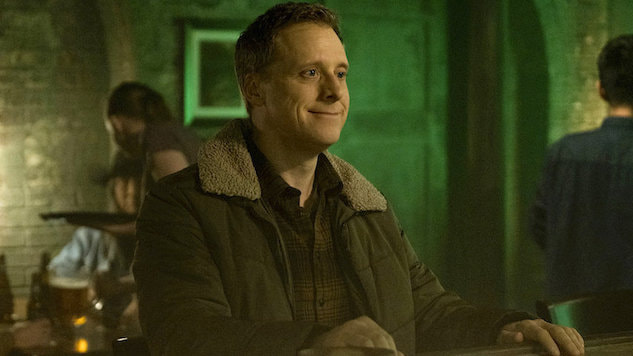
Network: Syfy
Season: 1
Watch on Syfy.com
Watch on Peacock
So 2021 is already a lot, but our prescription is to take a regular dose of Alan Tudyk in Resident Alien. The fantastically talented Tudyk finally gets to lead his own show in essentially a dual role as Dr. Harry Vanderspeigle and the alien who has secretly crash-landed on Earth and assumed the dead doctor’s appearance for safety. Much actual hilarity does ensue when the imposing local sheriff (Corey Reynolds) demands Vanderspeigle’s help in solving the murder of the lone town doctor in nearby Patience, Colorado. With an entertaining ensemble of quirky townspeople as support, the series unfolds like the mad cousin of Northern Exposure mashed up with John Carpenter’s Starman. And Tudyk is on point serving up a weekly Master’s class in physical comedy and pitch-perfect line readings. Plus, there’s an inspired side plot about a single kid in town who can see what Harry actually is, and their mutual détente of deep dislike is sublime. Get on this one—it’s the tension release valve you need. —Tara Bennett
15. Invincible
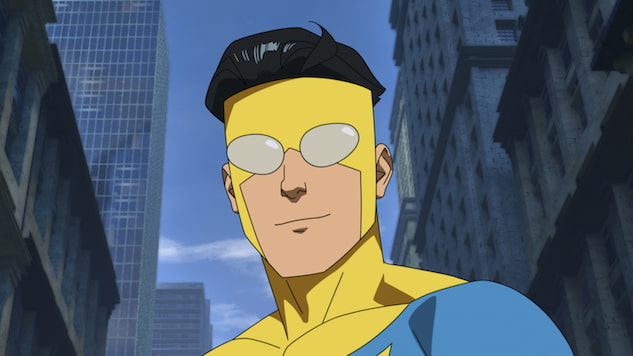
Network: Amazon Prime Video
Season: 1
There has been plenty of superhero greatness soaring through TV latley. Robert Kirkman’s creation is the latest to enter the arena, as he brings another of his beloved comic book serials to television with Invincible. A coming-of-age story meets a classic superhero tale, this animated adventure brings all the twists, turns, and frenzy we’ve come to expect from Kirkman’s episodic programs (you may recognize his name from The Walking Dead).
Invincible follows Mark Grayson (Steven Yeun), a seemingly dull 17-year-old kid. That is, until he finally inherits larger-than-life superpowers from his mega-cool dad Nolan (J.K. Simmons), also known by his hero name, Omni Man. Once he discovers his powers, the series becomes (a more brutal) Finding Nemo meets Iron Man, as the father and son learn how to grow from one another and coexist as heroes. And it’s not just these two bouncing into flight and sinking punches; two entire associations battle villains in the series, one of which is completely made up of sassy teenagers. The more heroes the better, right?
Invincible balances wild fight sequences with the actual logistics of these highly dangerous, orchestrated circumstances: these heroes wield their powers aggressively, of course, but they also have complex systems to evacuate areas and do damage control. Not only that, they reckon with their status as icons in society, and grasp what it means to “save” people. A flying start with stellar performances from both Yeun and Simmons, the future of Invincible is sure to excite. —Fletcher Peters
14. The Underground Railroad
Network: Amazon
Season: Miniseries
The 10-episode limited series, based on Colson Whitehead’s novel, is a fictional account of two runaway slaves, Cora (Thuso Mbedu) and her partner Caesar (Aaron Pierre), as they traverse the American South via a connection of literal hidden railroads. Helmed by Barry Jenkins, the series is lush and atmospheric while never shying away from the atrocities Cora and Caesar are running from, most notably the persistent slave catcher Ridgeway (Joel Edgerton), who stalks the duo relentlessly.
Each episode plays like a chapter in their journey, one stop on the railroad at a time, and Jenkins is deliberate in his worldbuilding. Georgia and South Carolina and North Carolina feel like different countries with different rules for how to treat Black folk: slaves in one, members of society in another, and illegal to exist in the open in the last. Jenkins fills every location with its own flavors. The first time we see the railroad, it feels like a huge sigh of relief—a literal bright light at the end of the tunnel.
It’s easy for a slavery drama to feel suffocating or paralyzing, and there are parts of The Underground Railroad that are designed to evoke discomfort and stagnancy. But Jenkins’ composition also allows us to examine every side of the story, every perspective at play. The series is urgent even in its slower moments. There is a thudding heartbeat at the center, proving that despite the trauma at the core of the story, the series is about perseverance. And in it is a tale ready to be deemed a classic. —Radhika Menon
13. The Mighty Ducks: Game Changers
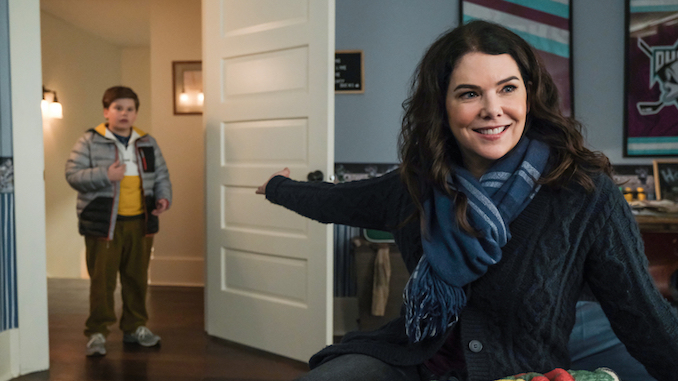
Network: Disney+
Season: 1
Firstly it must be said that The Mighty Ducks: Game Changers—the continuation of the franchise which began in 1992—is extremely validating. The Disney+ series doubles a group therapy for all the parents out there traumatized by how intense youth sports have become.
Game Changers understands this and has built its entire premise around this distressing phenomenon. It’s been 29 years since Gordon Bombay (Emilio Estevez, reprising his role) led the ragtag “District 5” hockey team to victory in the peewee championship. Two movies and an animated series followed, and now nearly three decades later, the Ducks are the reigning champions. They’re ruthless and nasty. Their parents bring private coaches to practice and employ sports psychologists. They are now—I know this will be hard to hear—the bad guys. In the series premiere, 12-year-old Evan Morrow (Brady Noon) gets cut from the team. “At this age, if you can’t be good at hockey, don’t bother,” the Ducks’ callous coach (Dylan Playfair) tells him.
That doesn’t go over well with Brady’s mom Alex (Lauren Graham), who decides to take matters into her own hands. Graham’s always charming schtick, which she perfected on Gilmore Girls, is on full display as the enthusiastic mom that just wants her son to be happy, and for the game of hockey to bring him the same joy it once did. So they create a new team of misfits who look, no surprise, very similar to the kids from the original movie. Those comfortable beats are welcome, though; this new series isn’t a game changer, unlike the advent of the original franchise. But it is a delight. And that’s something to quack about. —Amy Amatangelo
12. Rutherford Falls
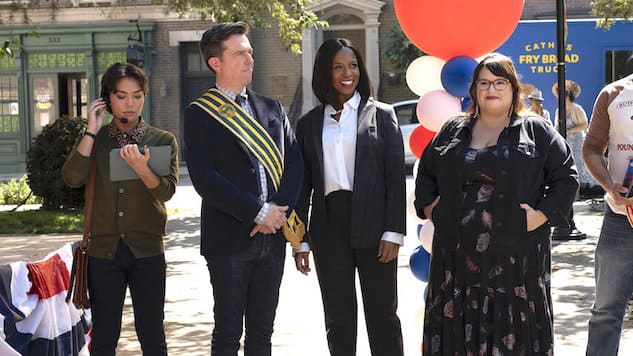
Network: Peacock
Season: 1
Rutherford Falls has all the makings of a typical Michael Schur sitcom: a catchy little jingle of a theme song, with mirrored musical interludes sprinkled into the story; topical pop culture references; an endearing slew of quirky characters; workplace banter. If you’ve even remotely enjoyed the comedies that have come before it (like Parks and Rec or Brooklyn Nine-Nine), you’re sure to enjoy Peacock’s latest addition to the bunch. The concept blends a traditional workplace comedy with deeper, more dramatic topics surrounding colonialism, Indigenous land, and, of course, “cancel culture”—all of which, when tossed around with clumsy humor, can land like a rotten egg on linoleum. Fortunately, with quick-witted writing and easy-going performances, Rutherford Falls opens unsuspecting, nuanced discussions on the once-fraught subjects.
The most controversial aspect about watching Rutherford Falls? You’ll have to subscribe to Peacock, NBC’s relatively new streaming platform that houses most of Schur’s other series. If that bounty hasn’t seduced you yet, let Rutherford Falls be the straw that breaks the camel’s back: it may not be perfect, but it’s more than worthy of a friendly stream. In other words, it’s one of Peacock’s first original shows with real promise—best to get started now, in case it hits the masses like a true protege of The Office or Parks and Rec might. —Fletcher Peters
11. Cobra Kai

Network: Netflix
Season: 3
For two and a half years, I’ve been singing the praises of Cobra Kai and every time I talked about the show, people would give me a befuddled look. There’s actually a show that continues the story of The Karate Kid? Yes! William Zabka and Ralph Macchio are both in it? Yes! It’s actually good? Yes! It airs on something you call YouTube Red or possibly YouTube Premium? Not anymore!
Everything about continuing The Karate Kid story 30+ years later seemed like a bad idea. Why muck with a beloved movie from so many people’s childhood? When would revivals stop messing with our memories? But instead of being a crass money grab, the series is a surprisingly clever take on aging high school rivalries while being a good old fashion throwback to the 1980s, complete with extended montages, rock and roll fight sequences, and a head-banging soundtrack. The series is the ultimate flip of the script, turning the erstwhile villain Johnny into the show’s main protagonist.
Part of what makes the show so special is its charming mix of the ridiculous with the more sublime. The series is a study in contradictions. A tongue-planted-firmly-in-cheek self-awareness is also the show’s secret weapon. Easter eggs and less-than-subtle shout outs to the movies are peppered throughout the season, even as Cobra Kai, at its heart, knows that it is ridiculous that two grown men are still jostling back and forth over a karate tournament that happened 36 years ago. Still, what really makes the show work is Zabka’s Johnny Lawrence. He’s a walking homage to that era, driving a beat-up Dodge caravan, listening to metal music on his cassette tape player, and eschewing modern technology. All in all, Cobra Kai , which thankfully has already been picked up for a fourth season, remains a pure, escapist delight. — Amy Amatangelo
10. Dickinson

Network: AppleTV+
Season: 2
Apple TV+’s clever anachronism-as-translation series returns in Season 2 more sure of itself. Not only have the musical drops become bolder (Sofi Tukker slotting in comfortably next to Volbeat, Monika Krause, and Cakes Da Killa feat. Rye Rye) and the slangy bits of dialogue more natural (“I’m at all of the balls; I’m a baller” could only ever work in the context of Dickinson), but the dimensions of the period-specific world as it exists beyond Emily’s brain have also deepened.
The most compelling element of this second season, though, always comes back to Emily. I mean, of course it does. Hailee Steinfeld is a magnetic performer, her sense of both comedic and tragic timing almost preternatural. But while her take on Emily was equal parts relatable and arresting from the minute she stepped into the frame in Season 1, Season 2 gives her even more to work with: namely, the question of fame, and whether or not it’s dangerous to seek it out; and also the question of love, and whether or not the world needs or deserves to know where your heart lives.
Honestly, the more Americans we can get thinking about how poetry and love and capital-T Truth can answer a moment of deep social and political divide right now, the better. That said, if all you want out of television right now is a bunch of shrewd Yankee witches claiming the right to be weird af and get lit off Emily’s dope-ass rhymes, Dickinson can do that for you, too. —Alexis Gunderson
9. All Creatures Great and Small
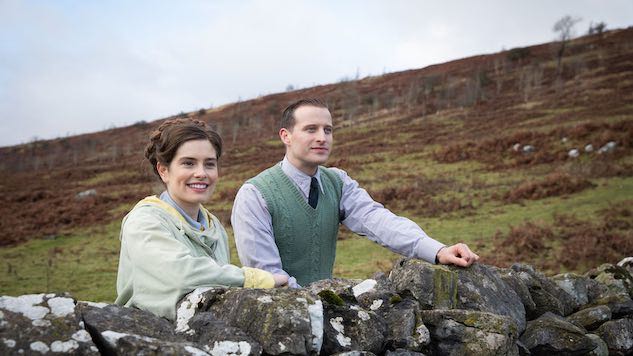
Network: PBS
Season: 1
As has been written about many times in this space, book-to-television adaptations can be a tricky beast to wrangle. But I can joyously report that the same warmth, humor, and gentle stories that fill my own well-worn copies (and much-played audiobooks) of James Herriot’s autobiographical novels come through beautifully in this new television version of All Creatures Great and Small.
Throughout the six episodes (and a Christmas Special), airing in the U.S. on PBS Masterpiece, we follow the daily life in the 1930s at Skeldale House, a veterinary practice that young James (Nicholas Ralph) joins as he graduates from school. Run by a good-hearted but difficult-to-please taskmaster, Siegfried Farnon (Samuel West)—who has fired every other assistant he has ever had—James must prove himself not only to his new boss, but also to the local farmers suspicious of newcomers and more modern methods of treatment.
Spiritually reminiscent of some of the best series to recently feature on Masterpiece, including The Durrells in Corfu, Victoria, and Downton Abbey, All Creatures Great and Small is the sort of show that is built upon a tender kindness. It is never saccharine, but wears its wholesomeness on its sleeve as we travel across the Yorkshire dales and experience the ups and downs of rural life. The show doesn’t shy away from difficult decisions James and the others must make, and one episode in particular is absolutely heartbreaking. But the series is always balanced by a plucky confidence in its storytelling and its tone, which ultimately keeps things light and cozy. This tenderly drawn slice of life champions honor, character, and the care of animals, and is a wonderful treat and a balm for the soul. —Allison Keene
8. It’s a Sin

Network: HBO Max
Season: Miniseries
From the beginning of It’s a Sin, the show’s ending is foreseeable. And yet it’s impossible to resist hoping for a different outcome: in a 1980s London plagued by AIDS, maybe these gay men we’ve come to know and love can make it out of the epidemic unscathed. Maybe government officials—and, inherently, the rest of the world—will take notice of the crisis as it unfolds and try to do something to help these men. But, no; Russell T. Davies’ limited series is a tragic, albeit masterful, retelling of the AIDS epidemic.
The main group—including the fashionable Roscoe (Omari Douglas), sweet Colin (Callum Scott Howells), guardian angel Jill (Lydia West), and lanky Ritchie (Olly Alexander) at the forefront—forms in and around London, at clubs, bars, apartment parties, becoming a larger and larger group of friends as they do. Then they’re crashing in an apartment together, tossing around witty nicknames and cups of tea.
It’s a Sin explores the HIV/AIDS illness as it unfurls in gay clubs and communities around the city—though it never villainizes or blames them for the crisis. Despite being a series almost entirely about the HIV/AIDS epidemic, It’s a Sin does not dawdle in statistics or tragedy. By energizing the show with a spirited cast, a storyline about growing up, and plenty of scenes that follow the joy of their kinship, Davies has created a tale that can entertain while still spotlighting an imperative point of discussion. —Fletcher Peters
7. Girls5eva
Network: Peacock
Season: 1
Meredith Scardino’s series, which is also executive produced by Tina Fey and Robert Carlock—her bosses from Netflix’s Unbreakable Kimmy Schmidt—focuses on the four remaining members of a one-hit wonder ‘90s girl pop group. Thrown together then by a lecherous and demoralizing manager, they had nothing in common, no autonomy over their talents or their bodies, and no idea what they were getting into. They sang songs entitled “Jailbait” and “Dream Girlfriends” (which included lyrics like “We’ve got the kind of birth control that goes in your arm. And tell me again why Tarantino’s a genius”). Now Wickie (Renée Elise Goldsberry), Dawn (Sara Bareilles), Summer (Busy Philipps), and Gloria (Paula Pell) have all but been forgotten by anyone beyond a bored Wikipedia editor—until a chance at a comeback has them taking a second look at where they’ve been and where they’re going.
Girls5eva is a cautionary tale about the era of low-rider jeans and sateen “going out tops”; about a time when young girls were supposed to giggle when their boyfriends compared them to the women in Maxim magazine and didn’t flinch if their professors offered to buy them drinks after class. But it also has a special present for the Gen Xers, late Millennials, Xennials, and anyone else who groks with its commentary on aging and the frustration and rage one can feel over being ignored and underappreciated—especially the frustrations we have with ourselves for not being “better.”—Whitney Friedlander
6. Cruel Summer
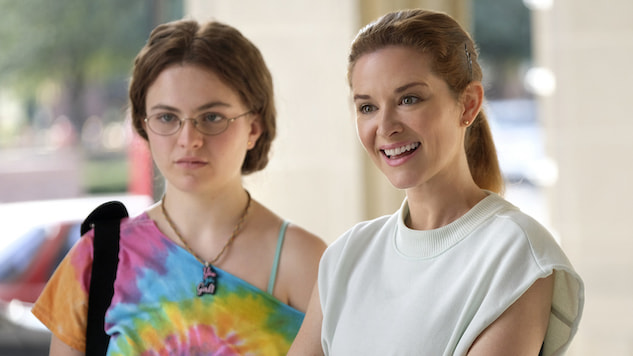
Network: Freeform (Next day on Hulu)
Season: 1
I had to give up taking notes on Cruel Summer, Freeform’s ‘90s-set teen mystery series, about 2,000 words in. That said, the very density that prompted me to get 2,000 words deep in a meticulous kind of madness before changing course is precisely the thing that’s has turned Cruel Summer into the internet’s next big generation-spanning hit. Truly, from its complex, triple-layered timeline to its compellingly intimate POV-flipping narrative structure to its viscerally accurate mid-90s details, Cruel Summer is custom-built to be an object of social media obsession.
In the one corner, you have Aurelia’s Jeanette Turner, who at any given moment is a sweetly awkward 15, or a recently popular 16, or a universally despised 17, and who may or may not be guilty of compounding another girl’s trauma. In the other corner, you have Holt’s Kate Wallis, who at any given moment is a universally beloved 15, or a freshly traumatized 16, or an acidly angry 17. In between them, you have a gulf of not-knowing regarding a chilling kidnapping and its sprawling consequences—a not-knowing that at any given moment might come from one character’s inherent duplicity, the natural gaps in another’s first-hand knowledge of a situation, or the fundamental unreliability of memory even before intense emotion is involved. There are some truths that are more real for some characters, and less for others; some realities that are more tangible in one moment than they are in the next.
The likelihood that one girl is lying and the other telling the truth hangs over Cruel Summer like a thundercloud, but in giving the audience just one walled-off chunk of each girl’s side of the narrative at a time, the possibility that they’re both telling a trauma story that’s true to them is just as present. In floating the mid-90s media’s take on Jeanette and Kate to the top of its story over and over again, Cruel Summer adds an important third perspective on the nature of reality, and all the ways in which it can be warped in the name of “truth.” —Alexis Gunderson
5. Shadow and Bone
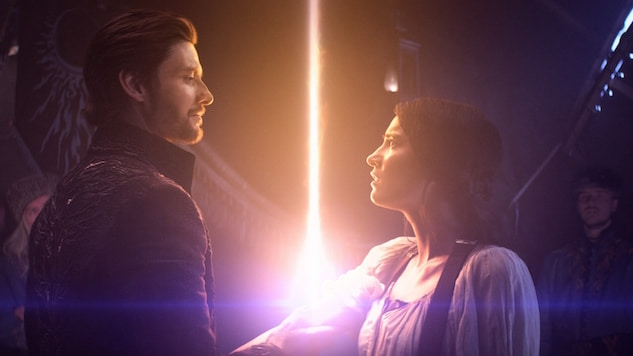
Network: Netflix
Season: 1
Since Game of Thrones, all the cable and streaming networks have been looking for its successor. For many reasons, not many have ignited on a zeitgeist scale. Shadow and Bone feels like the first real contender. It lands across the board with its production value, tone, visual effects, and engaging characters, culminating in an exhilarating season finale which all points to a potential large-scale hit.
As a non-reader of Leigh Bardugo’s Grishaverse novels, but a great admirer of richly crafted, adapted fantasy on television and film, I went into Netflix’s Shadow and Bone cold. All I expected was that—as with most intricate world-building that transitions from page to screen—there’s often a steep learning curve in the pilot, as the language, regions, factions, and magical terminology gradually makes sense. Costumes can be a big visual shorthand with that, and let me tell you, this series offers a level of visual embroidery porn I was not prepared for.
This fabric cheat sheet was deeply appreciated, because the drab military wear of orphans-to-First Army BFFs, cartographer Alina Starkov (Jessie Mei Li) and tracker Malyen “Mal” Oretsev (Archie Renaux) make it clear these two outsiders are nothing in the eyes of those they report to in their encampment on the edge of the Unsea, or the Shadow Fold, a black magic cloud of evil mojo created by a Grisha hundreds of years ago. It splits the country of Ravka in two, making access to needed foods, supplies, and resources dire. Impossible to cross without Grisha help (and even then, there’s no guarantee because of the volcra monsters flying inside, ready to attack), it’s a sore point for the entire world. In particular, the leader of the Grisha, General Kirigan (Ben Barnes), a.k.a. the Darkling, is a Shadow Summoner obsessed with fixing the Fold. But can only do that with the powers of a Sun Summoner, someone who has never existed in their history… until now.
Of particular success is how well Heisserer and his writers set up the required mythology in eight episodes without being exhausting, all the while deftly laying an emotional foundation. The show also weaves an ensemble of support characters into strong B and C stories that are interesting enough to exist on their own, yet masterfully bump in and out of lead’s journey throughout. Shadow and Bone has earned its place as our next great fantasy obsession—and thankfully, it has already been renewed for Season 2. —Tara Bennett
4. Zoey’s Extraordinary Playlist
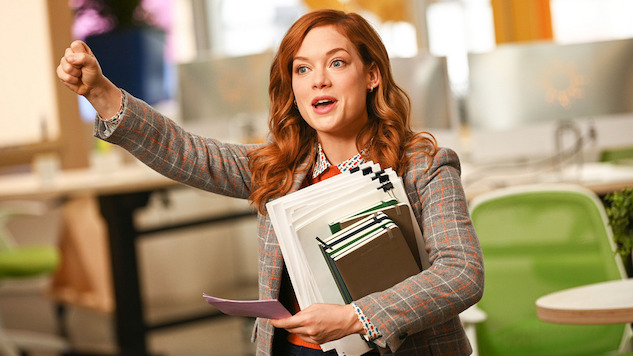
Network: NBC
Season: 2
There’s nothing on TV quite like Zoey’s Extraordinary Playlist.
Where else can you find exuberant musical numbers, razor sharp satire of the tech world, snappy, pop-culture infused dialogue (“You look like a sad Emma Stone Halloween costume”), groundbreaking choreography, and an eloquently honest portrayal of grief? Nowhere else, that’s where. Zoey represents all the potential network TV has to take big, creative swings and hit the mark.
In its second season, Zoey (deftly portrayed by Jane Levy)—who hears other characters inner most thoughts through song—is still reeling from the death of her father (Peter Gallagher) and faced with a daunting promotion at work while trying to decide between her two suitors Max (Skyar Astin) and Simon (John Clarence Stewart). There are some big changes (Lauren Graham is out, Harvey Guillén is in—at least for awhile), but it all works perfectly to create the kind of joyful, cathartic series we need right now. Though NBC has cancelled it, we’re still hopeful someone will pick up this joyful series for Season 3… —Amy Amatangelo
3. Hacks
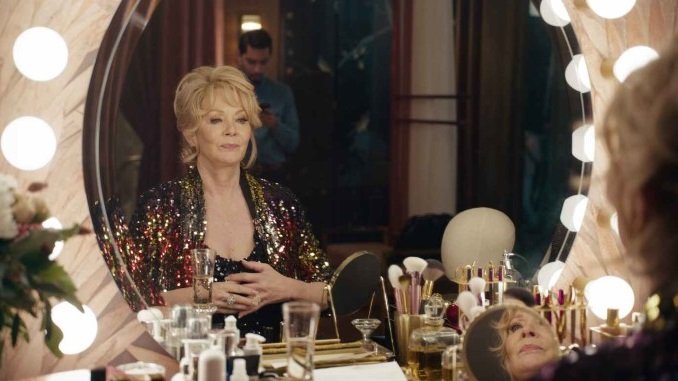
Network: HBO Max
Season: 1
HBO Max’s latest series Hacks follows 25-year-old writer Ava (Hannah Einbinder) as she tries to get her comedy career back on track after losing her job due to a bad tweet. Her journey takes her to Las Vegas, where she reluctantly starts writing material for Deborah Vance (Jean Smart), a comedy veteran whose life is much like the china she collects: beautiful to behold, but cold and empty within. Deborah fills her life with work due to the absence of a personal life, which she’s eschewed ever since her husband left her for her own sister decades ago.
The show is a traditional odd couple pairing. Ava is bisexual, a Bernie supporter, and a chronic oversharer—in essence, your classic media depiction of a Millennial. Deborah is brash, saying whatever she likes regardless of how others feel, and surrounds herself with gaudy opulence. Over the course of the series, they realize just how similar they are. Both of them are career-obsessed, more than a little self-centered, lack a personal life and, in the words of one side character, they’re “both psychotic bitches.”
Smart and Einbinder deftly pull off this two-hander thanks to their respective talent and excellent chemistry. Smart is at her peak here, moving from hilarious in one scene to quietly heartbreaking in the next. Deborah can be truly unlikable at certain moments, but the sensational Smart plays her with such subtlety and warmth that you still care about her—even though she has live fish pumped into her man-made lake.
With a strong cast and some stellar directorial choices, Hacks is an absolutely necessary addition to your watch list. —Clare Martin
2. Mare of Easttown
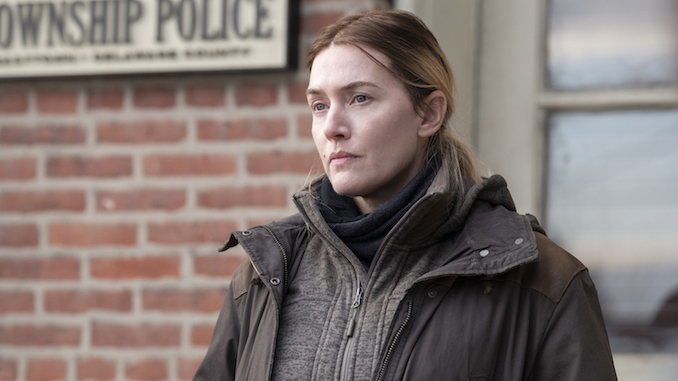
Network: HBO
Season: Miniseries
Is there such a thing as a sober, carefully considered obsession? If so, that’s what we encounter in the HBO limited series Mare of Easttown, a show that is ostensibly about a series of murders in a hardscrabble Pennsylvania town, but is, in reality, about the heavy pain of being alive. The plights of our time are all on display in the series—poverty, depression, drug addiction, suicide—and the debilitating effects are handled with masterful subtlety. This is a Kate Winslet vehicle through and through, and for an actor once described as having the “soul and attitude of a jobbing actress, trapped in the body of a movie star,” here again we see her embodying a pained, difficult character who is not always sympathetic. As Mare Sheehan, police detective and former high school basketball star, she has suffered, and suffered, and suffered some more in ways that leave her defiant, sarcastic, and cynical, but too tough to be broken. It’s not an easy psychological space to occupy, but Winslet, looking appropriately haggard except in the rare cases when she decides to be beautiful—moments of hope that are almost more painful than the perpetual fatigue of reality—is more than equal to the task, carrying the show with all the brilliance you’d expect from somebody so talented. If you come to Mare for Kate Winslet, as many will, you won’t be disappointed.
There can be a nagging tendency, when depicting “strong women,” to atone for years of under-representation on the screen by turning them into invulnerable super women, conflating the two genres—drama and comic book—that should be kept separate. Mare stands out for its realistic depictions of this strength, highlighting not just the impressive resilience of its women, but the ways in which the need for this resilience takes its toll, both over time and in harsh, shattering moments. When those characters falter, or even break, it only serves to highlight that underlying strength; these are portraits written and directed by human beings with a deep understanding of how life works on the psychological margins. —Shane Ryan
1. WandaVision

Network: Disney+
Season: Miniseries
In the Marvel comics, Wanda Maximoff is a reality-bending enchantress known as Scarlet Witch. Her power set is immense, and we have never seen the full scope of it within the movie universe—it’s too big, really, when you compare the fact that she and an actual god (Thor), and a wizard (Doctor Strange), are equals on a team with a Russian spy (Black Widow) carrying a gun, and an archer (Hawkeye). There are limits.
Not, however, when it comes to WandaVision itself, which is where we finally get to see the Marvel machine slightly unleashed. Marvel’s forays into television have not been altogether fantastic. But this series expands the story of characters we know from the movies in way that the movies simple did not have time to do. It also allows WandaVision creator Jac Schaeffer and director Matt Shakman to put a uniquely stylized and deeply emotional spin on a story that would have (as a movie) otherwise been shackled by the mandated aesthetics of the overall MCU. As such, in WandaVision, Wanda (Elizabeth Olsen) is also unleashed. She has used her immense power to create an insular world where she and her lost love, Vision (Paul Bettany), get to live happily ever after in classic sitcoms based on the likes of The Dick Van Dyke Show, Bewitched, and I Love Lucy. For fans of classic television, this is no satire; despite a few over-the-top ham moments, it is a loving homage to these series.
But of course, it’s not real. Throughout these half-hour episodes (both the ones we experience and the ones Wanda and Vision are living through), the world outside of this coping fantasy begins to creep in. First with bursts of color, then occasional off-script moments. Wanda stops these right away by rewinding and reliving the situation without the disruption. A clean story, nothing to disturb them. Just a husband and wife living a normal life in perfect suburbia (with the occasional advertisement for a Hydra watch or a Stark Industries toaster, of course).
Soon, however, Wanda is spinning out of control. Reality is closer than ever, and the teases we get to the world outside of Wanda’s creation, one where Vision is gone, get increasingly overt. She will have to come to terms with the truth soon, but it will hurt. And yet, I don’t really want reality to impede on Wanda’s created life at all. WandaVision’s core conceit—that sometimes you just want to escape into television, into fantasy, into a daydream—couldn’t be more meta. Let’s stay here in this happiness just a little while longer. The world outside is so dark. —Allison Keene
For all the latest TV news, reviews, lists and features, follow @Paste_TV.


